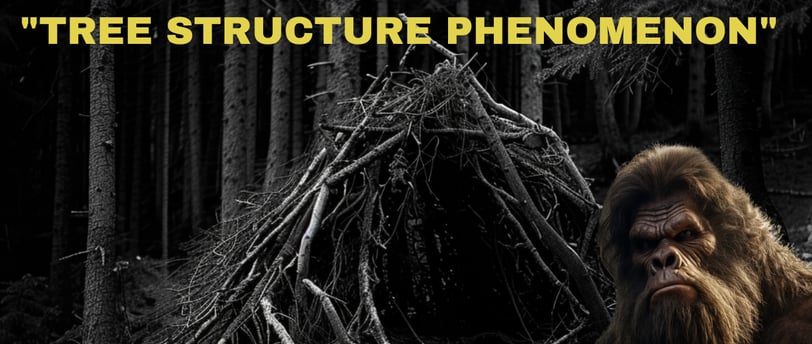"Tree Structure Phenomenon"
The use of tree structures as evidence is frequently motivated by the absence of more tangible evidence, like distinct footprints or biological clues.


In Bigfoot research, the "tree structure phenomenon" refers to atypical tree or branch forms that some think might constitute Sasquatch proof. Bent trees, X-shaped constructions, and teepee-like configurations are typical examples. Bigfoot researchers frequently see these formations in photos, and speculate that the creatures may utilize them as shelters, or territory markers.
As a cautious but optimistic researcher, you may interpret this data cautiously. The use of tree structures as evidence is frequently motivated by the absence of more tangible evidence, like distinct footprints or biological clues. Among the skeptical explanations are:
Natural Causes: Although they may appear strange, weather-related phenomena like wind, deep snow, or storms can cause trees to bend or break in strange ways.
Animal Behaviour: By foraging, scratching, or marking territory, large animals like deer, bears, or even beavers can cause damage to trees, leaving behind intentional-looking structures.
Human Activity: Researchers looking for hints may confuse shelters, markings, or lean-tos built by hunters, hikers, or survivalists for evidence of Bigfoot.
Pareidolia: People who have pareidolia may perceive deliberate designs or patterns in seemingly random natural formations. People who are searching for Bigfoot might be more likely to see haphazard tree or branch configurations as proof.
Some optimistic viewpoints include:
Communication or Marking Behaviour: It is a strong hypothesis that tree structures can be employed for behavioural marking or communication. If Bigfoot is a sentient being, it may use organic objects like branches and trees to send signals, just as other animals do with vocalizations or scent markings. These configurations can be a territorial boundary or a complicated language that has not yet been fully understood.
Constancy Across Sightings: The constancy of these tree structures is one of its most fascinating features. Similar types of structures—X formations, bending trees, and teepee-like arrangements—have been described in reports from a variety of sites, not just in Ontario but throughout North America. This overlap in sightings may point to a common behaviour among Bigfoot groups, making the sightings less likely to be coincidental or random.
Location Correlation: Tree constructions are frequently discovered near other indicators of potential Bigfoot activity, like vocalizations, footprints, or reports from eyewitnesses. The fact that certain forms of evidence tend to concentrate in particular regions raises the possibility that the structures are not merely products of nature. These clusters are seen by hopeful researchers as possible Sasquatch hotspots.
Structures' Unusual Nature: These formations often seem too complex or purposefully positioned to be explained just by the weather or the actions of animals. The concept of intelligent design is suggested by features such as branches stuck high into trees, massive limbs placed in ways that would require substantial strength or patterns that appear overly deliberate. According to some researchers, this strength and accuracy match descriptions of Sasquatch's stature and strength.
Cultural and Historical Significance: Native American folklore frequently describes enormous, humanoid animals that live in the woods. It also occasionally refers to tree ruins or other altered environments. This gives the results more historical and cultural significance and a clearer understanding of the reasons behind the researchers' optimism that the tree structure phenomena may be a remnant of an earlier connection with the environment.
In Bigfoot research, the tree structure phenomenon arouses both doubt and hope. Some people think that these structures, which include teepees, X forms, and bent trees, may be evidence of Sasquatch intelligence. These formations' regional consistency supports this notion. Some contend that they are probably the outcome of human behaviour, animal activity, or natural factors. As a researcher, you strike a balance between hope and caution; you acknowledge that more proof is needed but you still maintain hope that more research may reveal the real story behind these fascinating structures. While these structures may have natural or human origins, the optimistic side of the research still looks for stronger evidence. There's always a chance that future research will turn up fresh perspectives or stronger proof for the hypothesis.